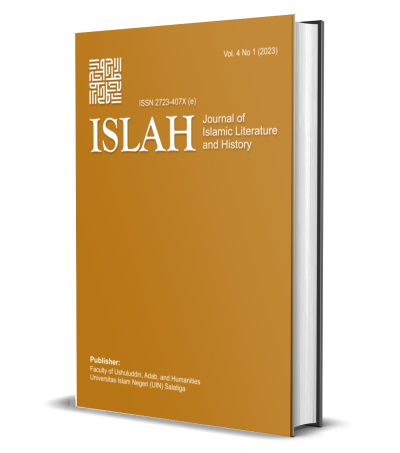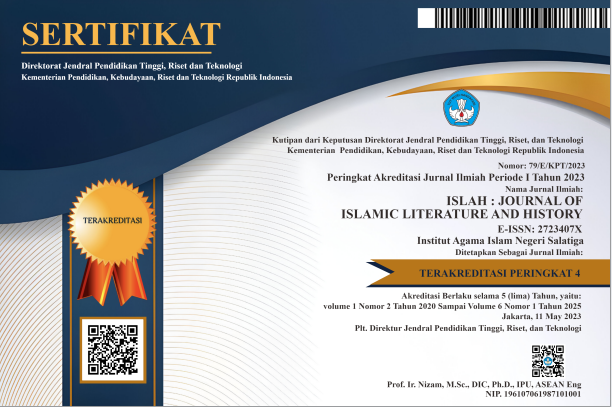Code Switching and Code Mixing in Arabic on Omer Kanan's Youtube Vlog
DOI:
https://doi.org/10.18326/islah.v4i1.1-24Keywords:
Code Switching, Code Mixing, Vlog, Religious FactorAbstract
Vlogs are objects of linguistic studies that are by current developments, where linguistic problems also appear in human communication patterns in interacting on social media. This study aims to determine the types, factors, and functions of code-switching and code-mixing contained in Omer Kanan's vlog. This type of research is descriptive qualitative, with data collection techniques using observation, desk review, and note-taking techniques. The data analysis method uses data reduction, data presentation, and concluding. Analysis of code-switching data using Hymes theory, and code-mixing data analysis using Hoffman theory. The data source comes from 18 Omer Kanan vlogs with the following analysis results: The types of code-switching and code-mixing found were inter-sentential switching, intra-sentential switching, and emblematic switching. intra sentential code-mixing, intra lexical code-mixing, and involving change pronunciation. Factors found in the form of habit patterns and the relaxedness of the speaker in communicating, expanding the audience network, and the attitude of the speaker's religiosity. The code-switching functions found in the vlog are in the form of quotation, addressee specifications, interjection, reiteration, message qualification, and personalization. Meanwhile, the code-mixing functions found are talking about a particular topic, repetition use for clarification, and expressing group identity.
References
Alhourani, Alaa. “Code Switching as a Communicative Strategy for the Bilingual Saudi Speakers at Jouf University.” Online Submission, 2018.
Barman, Utsab, Amitava Das, Joachim Wagner, dan Jennifer Foster. “Code Mixing: A Challenge for Language Identification in the Language of Social Media.” In 1st Workshop on Computational Approaches to Code Switching, Switching 2014 at the 2014 Conference on Empirical Methods in Natural Language Processing, EMNLP 2014 - Proceedings, 2014. https://doi.org/10.3115/v1/w14-3902.
Caterine, Widya. et.all. Sociolinguistics : A Social Linguistics Reality. Malang: UB Press, 2021.
David, Eribka, Mariam Sondakh, dan Stefi Harilama. “Pengaruh Konten Vlog dalam Youtube terhadap Pembentukan Sikap Mahasiswa Ilmu Komunikasi.” Acta Diurna, 2017.
Habibi, Moch. “Bahasa dan Konsep Agama: Studi Alih Kode dalam Ceramah Agama K.H Jamaludin.” Buletin Al-Turas, 2018. https://doi.org/10.15408/bat.v24i2.8750.
Hikam, Fani Fazrul, Fickyh Verdhyawan Santoso, dan Mahdi Mahdi. “ANALISIS FENOMENA CAMPUR KODE DAN ALIH KODE PADA MEDIA SOSIAL TWITTER.” Prosiding Seminar Nasional Sasindo, 2021. https://doi.org/10.32493/sns.v2i1.16702.
Juzeleniene, Saulute, Rita Baranauskiene, dan Skirmante Sarkauskiene. “What language emotional hydra speaks: GBLL for bilingual children.” In Proceedings of the European Conference on Games-based Learning, 2014.
Likhitphongsathorn, Teeratorn, dan Pattama Sappapan. “Study of English Code-mixing and Code-switching in Thai Pop Songs.” Flltcp, 2012.
Nurhikmah, Andi, Muhammad Basri, dan Amirullah Abduh. “Bilingual Communicative Competence Development of the Students in Indonesian Higher Education.” Asian EFL Journal 27 (1 April 2020): 172–87.
Pratapa, Adithya, Gayatri Bhat, Monojit Choudhury, Sunayana Sitaram, Sandipan Dandapat, dan Kalika Bali. “Language modeling for code-mixing: The Role of Linguistic Theory based Synthetic Data.” In ACL 2018 - 56th Annual Meeting of the Association for Computational Linguistics, Proceedings of the Conference (Long Papers), 2018. https://doi.org/10.18653/v1/p18-1143.
Rahardi, Kunjana. Kajian Sosiolinguistik Ihwal Kode Dan Alih Kode. Yogyakarta: Ghalia Indonesia, 2010.
Rohmani, Siti, Amir Fuady, dan Atikah Anindyarini. “coronavirus disease 2019 (COVID-19) pada Anak.” Jurnal Penelitian Bahasa, Sastra Indonesia dan Pengajarannya, 2013.
Rulyandi, Rulyandi, Muhammad Rohmadi, dan Edy Tri Sulistyo. “Alih kode dan campur kode dalam pembelajaran bahasa Indonesia di SMA.” Paedagogia 17, no. 1 (2014): 27–39.
Rusli, Wan, Azianura Shaari, Siti Zaidah Zainuddin, Ng Shi, dan Aizan Amin. “Intra and Intersentential Code-switching Phenomena in Modern Malay Songs.” 3L The Southeast Asian Journal of English Language Studies 24 (27 September 2018): 184–205. https://doi.org/10.17576/3L-2018-2403-14.
Sabilla, Annisa. Pengaruh Alih Kode dan Campur Kode pada Kanal Youtube “Nihongo Mantappu” Terhadap Eksistensi Pemakaian Bahasa Indonesia di Era Globalisasi, 2020. https://doi.org/10.31227/osf.io/8ahvx.
Sholihah, Rizki. KONTAK BAHASA: KEDWIBAHASAAN, ALIH KODE, CAMPUR KODE, INTERFERENSI, DAN INTEGRASI, 2018.
Suci Utami ayuningtias, Retno Purnama Irawati, Hasan, dan Bustri. “Penggunaan Istilah Bahasa Arab Oleh Aktivis Rohis Di Universitas Negeri Semarang (Analisis Semantik Dan Sosiolinguistik).” Lisanul’ Arab: Journal of Arabic Learning and Teaching Vol.6, no. No.1 (2017): 6–15.
Downloads
Published
Issue
Section
License
Copyright (c) 2023 Rika Astari, Umnia Amina, Muhammad Irfan Faturrahman

This work is licensed under a Creative Commons Attribution-ShareAlike 4.0 International License.
Copyright
Authors retain copyright and grant the journal right of first publication with the work simultaneously licensed under a Creative Commons Attribution-ShareAlike 4.0 International License. In line with the license, authors are allowed to share and adapt the material. In addition, the material must be given appropriate credit, provided with a link to the license, and indicated if changes were made. If authors remix, transform or build upon the material, authors must distribute their contributions under the same license as the original.
Licensing

This work is licensed under a Creative Commons Attribution-ShareAlike 4.0 International License.









